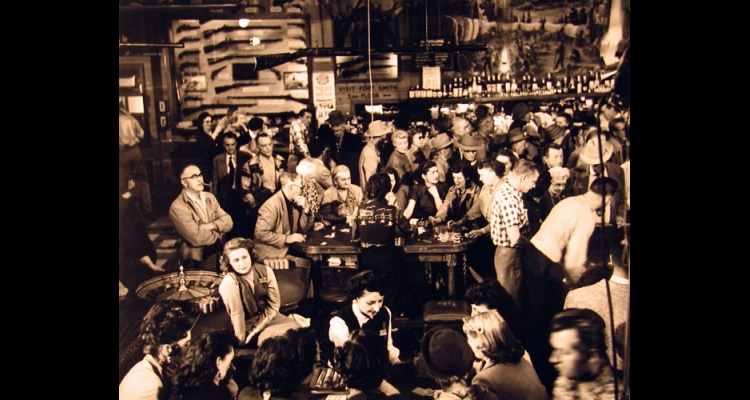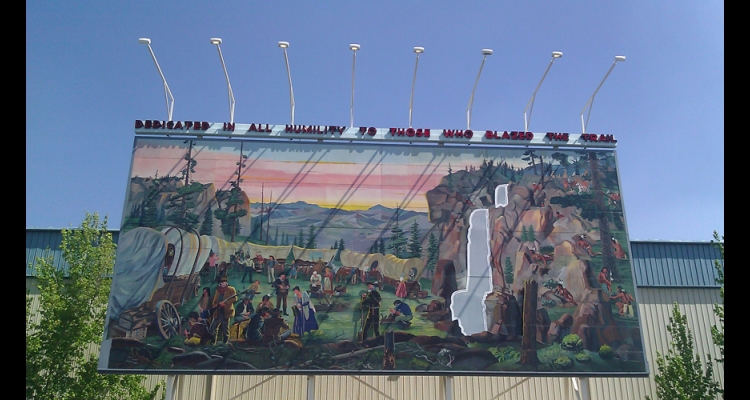Harolds Club
On his twenty-fifth birthday, February 23, 1935, Harold Smith Sr. opened a tiny gambling club in Reno, Nevada. He had come to “the biggest little city” because California was cracking down on the carnival games his family ran in the Bay Area, and in 1931 Nevada had legalized gambling. Smith called his place “Harold's Club”—with an apostrophe—and it was to become one of the most famous gambling place of its day and one of the first modern casinos. (The apostrophe later disappeared from the name.) The new club measured only 25 feet by 150 feet, and featured one roulette wheel. It lost money, and after a few months Harold's father, Raymond I. “Pappy” Smith, arrived to turn things around as general manager. In the meantime Harold had been joined by his brother, Raymond A., who during the Great Depression could not find work in his banking profession.
Pappy soon developed a reputation for trying anything, including letting players bet on which hole a scampering field mouse would enter. The stunt gained Harolds its first national publicity. It was a prime example of Pappy's genius for promotion that gave the club a major advantage over its rivals, which were dingy, unappealing places leery of advertising their business. The most famous promotion involved “Harolds Club or Bust” roadside billboards erected worldwide, and other advertising took the same adventurous tack, publicizing the club anytime and anywhere it could.
In addition to this revolutionary advertising, the Smiths had another advantage, and that was Pappy's carnival-worker philosophy of treating customers with a smile and a fair hand. Run an honest game, the father said, let players win something, and they'll return. So under Pappy's leadership, a series of innovations began that would turn Harolds Club and Reno into world-famed tourist attractions, taking the city far beyond its “Divorce Capital” notoriety. These included a friendly atmosphere; large numbers of women dealers; an emphasis on slot machines as well as table games; handouts to big losers; and a themed casino emphasizing the Old West, including a Roaring Camp museum, an outdoor wagon-train mural, and a series of Pioneer Nevada books.
If innovations helped Harolds become Nevada's biggest casino, World War II had an equal impact. Defense workers and soldiers on leave poured in from California's Bay Area, but the real bonanza came in 1942 when the Reno Army Air Base opened at nearby Stead, bringing thousands of eager customers with ready cash. After the war, the ex-soldiers returned and urged others to come.
Despite his fame, Pappy did not become an owner until 1959, when he purchased one-third interest from Harold's ex-wife Dorothy, who had acquired her share during the divorce. Raymond A. also owned one-third. Numerous other Smiths—wives, children, and even ex-wives—worked in Harolds at one time or another in a singular mix. For instance, shortly after Harolds opened, Pappy's ex-wife, Dora, reappeared with a new husband, and both became dealers. Dorothy returned to work in 1953, six years after divorcing Harold. Pappy's brother, Harry, dealt almost from the beginning until he died in 1955; he was noted not only for his tremendous good luck for the house but for selling Watchtower pamphlets for Jehovah's Witnesses.
It remains unclear why or when the apostrophe disappeared from “Harold's.” In his autobiography, Harold said he eliminated it when installing the first large outdoor sign, but photos show the club's signs with and without the apostrophe well into the 1940s. Whatever the date, Harold said he deleted the apostrophe so the club wouldn't sound “grandiloquent.” Another story has it that Pappy gradually eliminated the apostrophe because he wanted the club to be less his son's and more the family's. This story reflects the animosity that sometimes existed between father and son. Pappy, not Harold, was the public face of the club and was considered the entrepreneurial genius who created modern Nevada gambling by making it credible and fun. This must have deeply irked Harold and might have contributed to his heavy drinking and gambling in later years. Certainly, he, Pappy, and even Raymond argued frequently at board meetings and presumably elsewhere.
In 1954 the Smiths completed a seven-story, $4 million “tower” to greatly expand gaming facilities, but it was too narrow and cramped to fully achieve this purpose. That placed it on a par with the rest of the club, a warren of rooms which had expanded bit by bit into the second floor and nearby buildings, a sort of maze in which customers sometimes found themselves stumbling past construction zones. The escalator to the second floor was typical: so narrow and steep that people sometimes toppled over each other. Even so, the tower's seventh-floor Fun Room, despite being uncommonly small, featured many great entertainers of the era including Harry James, Louis Armstrong, Petula Clark, Dionne Warwick, Rosemary Clooney, Trini Lopez, and Olivia Newton-John.
On July 1, 1962, apparently to generate needed cash, the Smiths sold the club property for $16.5 million to the Webbel Corporation and leased it back under a twenty-five-year arrangement. In the new corporation, Harold and Pappy each owned forty-eight percent and Raymond, four percent.
Pappy died in 1967. Harold began drinking heavily again, and the operation began to decline. In June 1970, the family sold the club to billionaire Howard Hughes, in part because the Webbel deal apparently created liquidity problems. But according to oral histories of several family members, Harold Sr.'s gambling was the main cause—his debts had grown so huge that the club had to be sold to pay them. However, attorney Jack Streeter, who handled the sale, denied this, saying Harold simply didn't want to run the club anymore. In any event, Hughes' operatives immediately began making Harolds more professional and—many employees felt—cold. Keno operator Jessie Beck took her game to the Riverside Hotel and many employees followed. In the succeeding months, numerous employees quit.
This mass exodus might appear strange to an outsider because Harolds could seem frustratingly chaotic in comparison to the more orderly Howard Hughes Corporation. The Smiths preferred to hire inexperienced dealers, often with little or no training, especially in the early days. Players sometimes cheated the novices, but more often helped them learn the games. Harold might fire a dealer and Pappy would immediately hire her back, or vice versa. One time Raymond A. fired an entire shift, but the workers were told to return in an hour because Raymond was just trying to impress his new girlfriend. Pappy wandered around dealing a “poor bastards” hand in which everyone won, or he or Harold doubled bets on a whim. Harold would be friendly or brusque depending on his mood. Late in life, Pappy decided that dancing would keep him healthy, and women dealers were invited upstairs to twirl during their breaks. It all sounds preposterously improvisational. But in fact, employees loved working there and often stayed to gamble or drink at the Silver Dollar Bar. After the Smiths sold, former employees created Harolds Club Pioneers, which still meets regularly.
In 1971, Hughes opened a $20 million, four-story expansion, but in 1988 his Howard Hughes Corporation sold to The Fitzgerald Group of Reno. In the meantime, Harold Sr. had died in 1985.
In 1995, Gamma International acquired Harolds through its subsidiary American Gaming and Entertainment of Atlantic City, but on March 31 closed the building pending its proposed re-invention as Harolds Club Down Under. It never reopened, except for four hours on March 31, 1997, to retain its gaming license. In 1999, Harrah's bought the building and on December 16 imploded it and the adjacent Nevada Club, replacing them with an outdoor plaza.
Harolds Club failed because it could not compete with second-generation casinos. It had no hotel, crucial for a modern customer base, and it lacked the large showrooms and spacious main floor of newer casinos, where the music of top entertainers boomed from open lounges. Equally fatal, the Smiths had failed to expand by buying additional property in Reno or at Lake Tahoe—acquisitions that competitor William Harrah made while building a superior gaming empire; this left little maneuvering room for later Harolds owners. But one suspects that even though Harolds lasted twenty-five years after the purchase by Howard Hughes, the most telling factor was that its heart was gone. In the end, it could not survive without the quarreling, innovative, and homespun Smiths.
All that remains of Harolds is the old wagon-train mural, preserved at the Reno Livestock Events Center.
Article Locations
Related Articles
None at this time.
Further Reading
None at this time.



